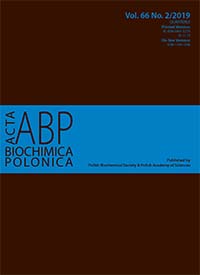Evaluation of the localization and biological effects of PAMAM G3 dendrimer-biotin/pyridoxal conjugate as HaCaT keratinocyte targeted nanocarrier
Abstract
Recognition of the molecular mechanisms of keratinocyte participation in normal skin homeostasis and in pathogenesis may lead to creation of more effective tools for topical application of cosmetics, cosmeceutics and drugs to a particular location within the skin for prevention and therapy of many skin disorders and diseases. For this purpose, the PAMAM G3 dendrimer with amide linkages of 9 biotin molecules and 10 molecules of pyridoxal phosphate (BC-PAMAM) was constructed, and its biological properties and cellular uptake and localization were investigated in the HaCaT keratinocytes. BC-PAMAM is nontoxic for HaCaT cells, as estimated by two assays (Neutral Red and tetrazolium salt reduction, XTT), and revealed low apoptosis induction at up to 50 µM concentration. Fluorescent labeled BC-PAMAM accumulates in HaCaT cells with high efficiency in a concentration–dependent manner. Its mitochondrial localization, estimated as Mander’s colocalization coefficient, is substantially lower than the native PAMAM, and that correlates with its cytotoxicity. The only undesirable, but significant inhibitory effect on cell mobility, evaluated by the wound healing test, was observed at 10 µM BC-PAMAM. The important anti-inflammatory action of BC-PAMAM was clearly documented by decreased production of total IL-1α, assayed with an ELISA test with unstimulated and stimulated by bacterial antigens (LPS and GroEL) HaCaT cells. Thus, it is expected that the biotin pyridoxal phosphate conjugated PAMAM may be considered as a potential carrier for safe delivery of vitamins and drugs into the epidermis.
Acta Biochimica Polonica is an OpenAccess quarterly and publishes four issues a year. All contents are distributed under the Creative Commons Attribution-ShareAlike 4.0 International (CC BY 4.0) license. Everybody may use the content following terms: Attribution — You must give appropriate credit, provide a link to the license, and indicate if changes were made. You may do so in any reasonable manner, but not in any way that suggests the licensor endorses you or your use.
Copyright for all published papers © stays with the authors.
Copyright for the journal: © Polish Biochemical Society.


